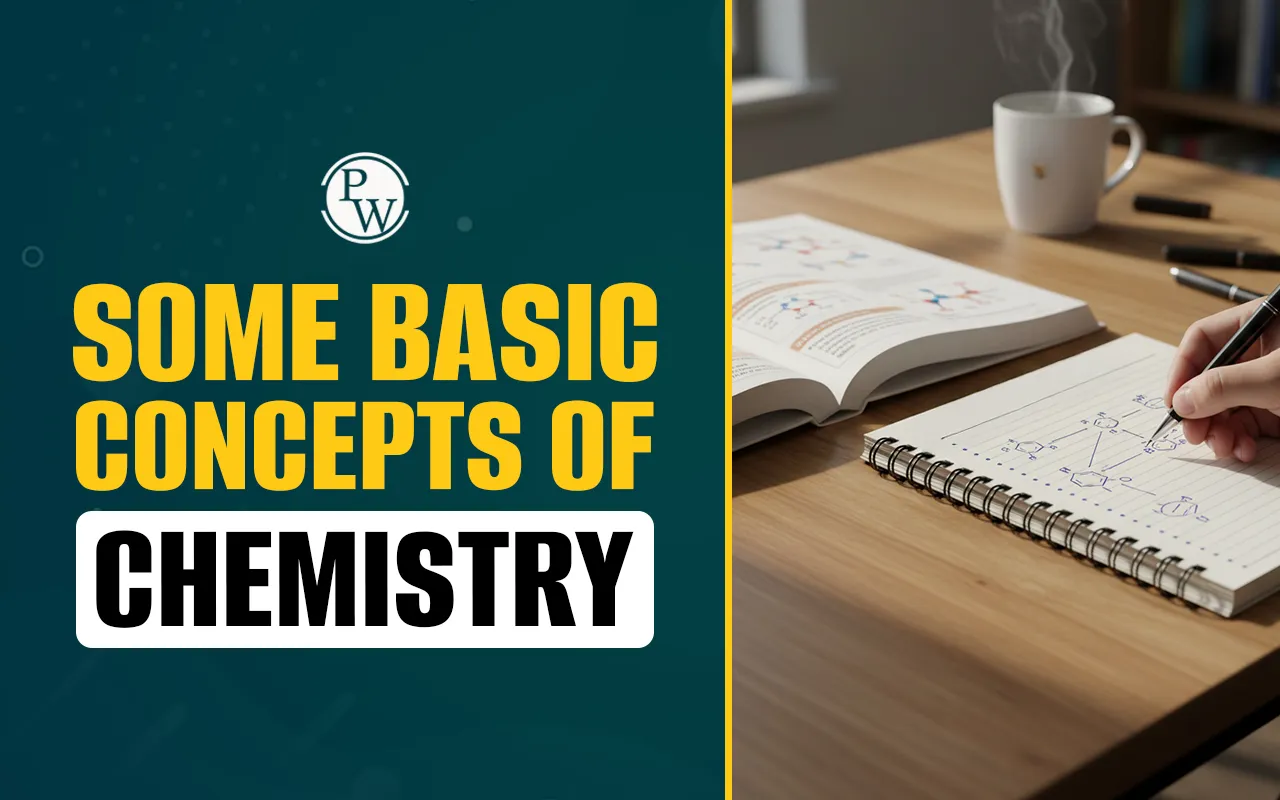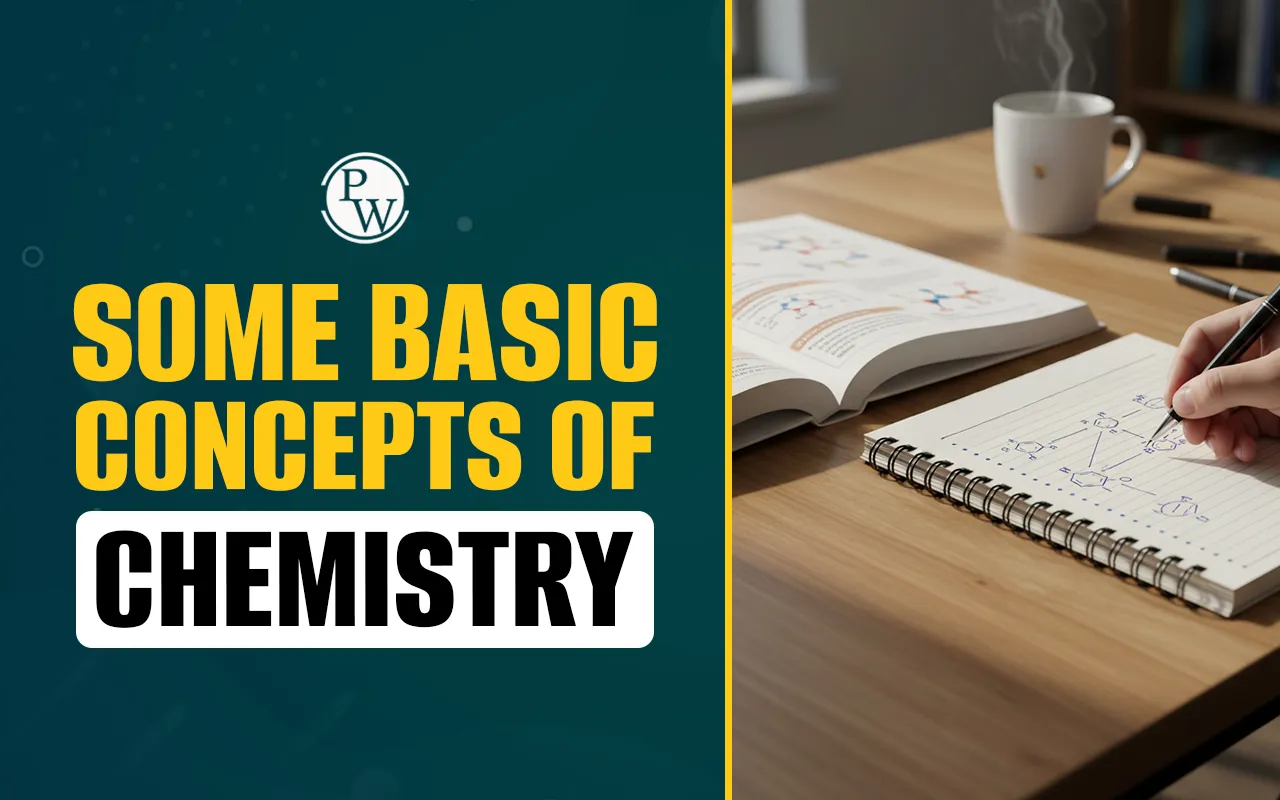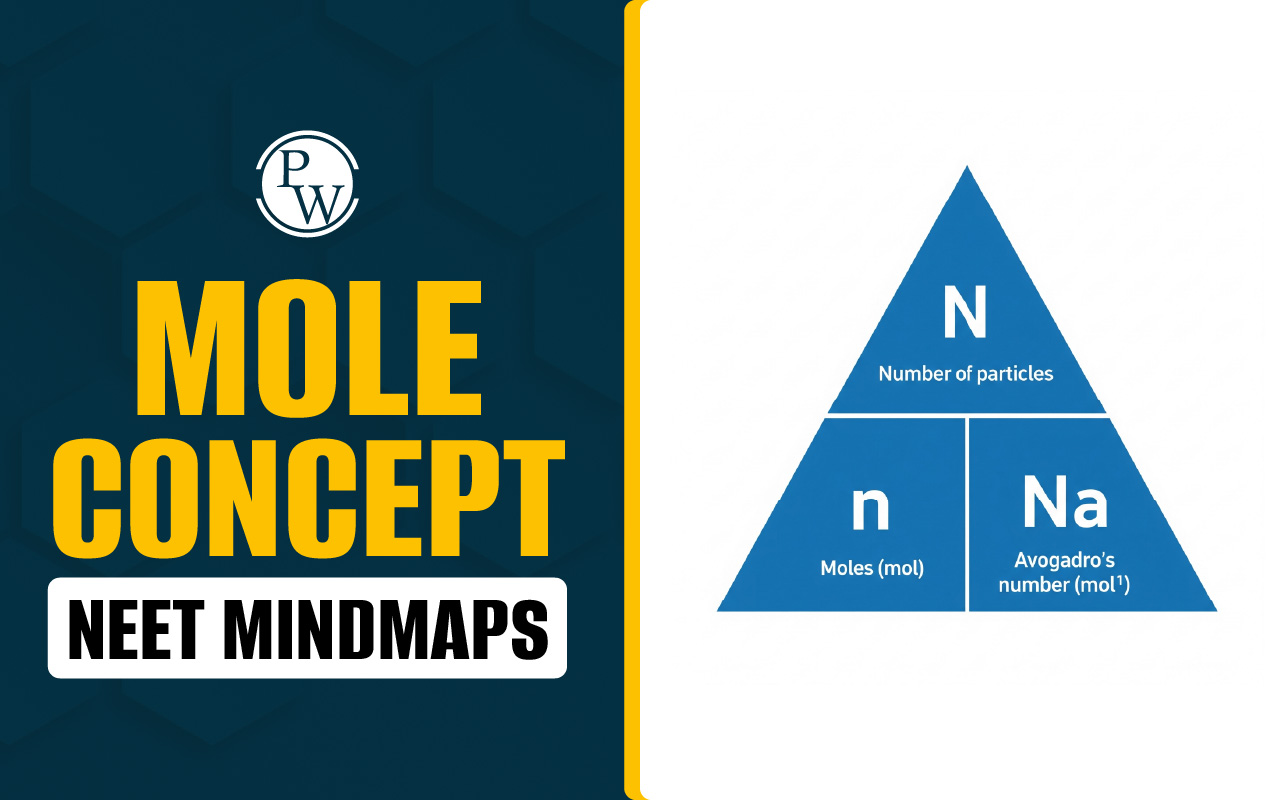

Some Basic Concepts of Chemistry form the foundation for studying all chemical topics. They help students understand how substances react and allow precise calculations in chemical problems. Learning these concepts clearly improves speed and accuracy in numerical and theoretical questions.
Further, topics like Mole Concept Calculations, Limiting Reagent Concept, Molarity and Molality, Empirical and Molecular Formula, Stoichiometric Calculations, and Significant Figures are generally tested in NEET. Students should practice these topics regularly. They also need to revise formulas and methods multiple times. A strong understanding of these concepts gives confidence and ensures better performance in competitive exams.
Some Basic Concepts Of Chemistry Overview
Some Basic Concepts of Chemistry help students understand chemical reactions better. Candidates need to know how to calculate moles, concentrations, and products. They also need to understand how to find limiting reagents. Practising these calculations improves problem-solving skills.
Students who master these basics can approach complex chemistry problems easily. These concepts are used in many topics across the NEET syllabus. Students are advised to revise regularly and practise multiple examples to gain speed and accuracy in solving numerical questions.
|
Some Basic Concepts of Chemistry Overview |
|
|---|---|
|
Concept |
Description |
|
Mole Concept Calculations |
Calculating moles, mass, number of particles, and gas volume using Avogadro’s number and molar mass |
|
Limiting Reagent Concept |
Finding the reactant that limits the reaction and calculating the maximum product formation |
|
Molarity and Molality |
Measuring concentration of solutions using moles per litre or per kilogram of solvent |
|
Empirical and Molecular Formula |
Calculating the simplest and actual ratio of elements in compounds |
|
Stoichiometric Calculations |
Using balanced chemical equations to find quantities of reactants and products |
|
Significant Figures |
Ensuring precision in measurements and calculations |
Note: Students are advised to solve examples under each topic. Therefore, regular practice helps improve understanding and accuracy.
Also Check:
Topics Under Some Basic Concepts Of Chemistry
Students should focus on key topics under the basic concepts of Chemistry that are often asked in NEET exams. Understanding these topics helps solve both theoretical and numerical questions efficiently. Here are some of the key topics under this unit:
Mole Concept Calculations
This topic helps students understand the relationship between mass, moles, and the number of particles in a substance. Using the molar mass and Avogadro’s number, students can calculate how many moles are present in a given mass, how many atoms or molecules it contains, and the volume of gases at standard conditions. These calculations are essential for solving chemical reaction problems and understanding the amounts of substances involved.
Here, candidates should learn to:
-
Calculate moles from mass or number of particles
-
Determine the number of atoms, molecules, or ions
-
Find volumes of gases at standard temperature and pressure (STP)
-
Apply to reaction and problem-solving
Limiting Reagent Concept
In a chemical reaction, sometimes one reactant runs out before the others. This reactant is called the limiting reagent. Under this topic, students learn to identify which reactant limits the reaction by comparing the moles of all reactants using a balanced chemical equation. They then calculate how much product can be formed and how much of the other reactants remain. The following points are to be learnt in this topic:
-
Identify the limiting reactant using mole ratios
-
Calculate the maximum product formed
-
Determine leftover reactants
-
Apply to predict reaction outcomes
Molarity and Molality
These concepts measure how concentrated a solution is. Molarity (M) is the number of moles of solute per litre of solution, and it changes with temperature. Molality (m) is the number of moles of solute per kilogram of solvent and does not depend on temperature. Students also practice converting between units, preparing solutions of required concentrations, and using these measures in reaction calculations.
Students learn the following factors under the molarity and molality topic:
-
Calculate the molarity and molality of solutions
-
Convert between molarity and molality
-
Prepare solutions of the desired concentration
-
Apply in chemical reaction calculations
Empirical and Molecular Formula
The empirical formula shows the simplest whole-number ratio of elements in a compound, while the molecular formula shows the actual number of atoms of each element. Students learn to calculate the empirical formula from experimental data, then use molar mass to find the molecular formula. This helps in understanding the composition and structure of compounds and is essential in chemical analysis.
Candidates should learn here:
-
Determine the simplest ratio of elements (empirical formula)
-
Find the actual number of atoms using the molar mass (molecular formula)
-
Apply to analyse compound composition
-
Useful in chemical problem-solving
Stoichiometric Calculations
Stoichiometry involves using balanced chemical equations to calculate quantities of reactants and products. Students learn to relate moles of one substance to another, find the amount of product formed from given reactants, and determine how much reactant is needed for a reaction. These calculations are important for solving chemical problems accurately and predicting outcomes in experiments.
Candidates learn the following points in this topic:
-
Use balanced equations to relate reactants and products
-
Calculate quantities of reactants and products
-
Solve numerical problems based on reactions
-
Apply in the laboratory and NEET practice
Significant Figures
Significant figures show the precision of a measurement. Students learn how to write numbers correctly to reflect the accuracy of data and calculations. Rules include keeping meaningful digits and rounding appropriately. Using significant figures properly helps avoid errors in chemical calculations and ensures results are reliable and precise.
Here are the points covered under the following topic:
-
Identify significant figures in measurements
-
Apply rules for addition, subtraction, multiplication, and division
-
Maintain precision in calculations
-
Avoid errors in numerical and experimental work
Importance of Some Basic Concepts Of Chemistry in NEET Exams
Some Basic Concepts Of Chemistry are important for NEET because many questions come from these topics. Mole Concept Calculations and Stoichiometric Calculations appear frequently in exams. Limiting Reagent Concept and Molarity/Molality also have a high number of questions. Empirical and Molecular Formula, along with Significant Figures, are tested to check students’ calculation accuracy.
Understanding these concepts helps candidates solve problems faster. It also ensures fewer mistakes in numerical calculations. Practising these topics regularly helps students manage their exam time better. In addition, these concepts form the base for advanced topics like chemical kinetics and equilibrium.
Weightage of Some Basic Concepts Of Chemistry in NEET Exams
The topics under Some Basic Concepts Of Chemistry have significant weight in NEET exams. Mole Concept and Stoichiometric Calculations carry more marks due to their frequent applications. Limiting Reagent Concept and Molarity/Molality also appear in many questions. The Empirical and Molecular Formula and Significant Figures test the understanding of basic calculations in students.
|
Approximate Weightage of Some Basic Concepts of Chemistry in NEET Papers |
||
|---|---|---|
|
Topic |
Approximate Weightage (%) |
Approximate Number of Questions |
|
Mole Concept Calculations |
20 |
4 to 5 |
|
Limiting Reagent Concept |
15 |
3 to 4 |
|
Molarity and Molality |
15 |
3 to 4 |
|
Empirical and Molecular Formula |
15 |
3 to 4 |
|
Stoichiometric Calculations |
25 |
5 to 6 |
|
Significant Figures |
10 |
2 to 3 |
Note: It should be noted that weightage may vary slightly each year. Students should focus on high-weight topics, but revise all topics regularly.
Preparation Tips for Some Basic Concepts Of Chemistry in NEET
Students should follow a planned approach while preparing. First, they should learn formulas and basic definitions. Then, they should practise numerical problems for each topic. Revising multiple times is important to remember concepts. Solving previous year questions also improves speed and understanding.
Some of the preparation tips include:
-
Allocate study time according to topic weight and difficulty.
-
Practise Mole Concept and Stoichiometric Calculations daily.
-
Revise Limiting Reagent and Molarity/Molality regularly.
-
Use tables and notes to memorise formulas quickly.
-
Solve mock papers to improve accuracy and speed.
-
Pay attention to Significant Figures in every calculation.
Some Basic Concepts of Chemistry Practice Questions
Practice questions like these help reinforce fundamental chemistry concepts, including measurements, calculations, and significant figures. Solving such problems improves accuracy and builds a strong foundation for more advanced topics.
Taking into account of the significant figures, what is the value of 9.99 m –0.0099 m?
(1) 9.9801 m
(2) 9.98 m
(3) 9.980 m
(4) 9.9 m
Determine the number of significant figures following:
(1) 1005000 cm
(2) 1.005 g
(3) 0.000125 m
(4) 10000 km
(6) 2002 mL
(5) 0.02002 s
(7) 200.200 days
The volume of a liquid is 20.5 mL. Which of the following sets of measurement represents the value with good accuracy?
(1) 18.6 mL, 17.8 mL, 19.6 mL, 17.2 mL
(2) 19.2 mL, 19.3 mL, 18.8 mL, 18.6 mL
(3) 18.9 mL, 19.0 mL, 19.2 mL, 18.8 mL
(4) 20.2 mL, 20.5 mL, 20.3 mL, 20.1 mL
What weight of BaCl 2 would react with 24.4 g of sodium sulphate to produce 46.6 g of barium sulphate & 23.4 g of sodium chloride?
(1) 29.8
(2) 56.1
(3) 45.6
(4) 46.4
The law of definite proportions is not applicable to nitrogen oxide because:
(1) Nitrogen atomic weight is not constant
(2) Nitrogen molecular weight is variable
(3) Nitrogen forms multiple compounds with oxygen
(4) oxygen atomic weight is variable
Element N forms five stable oxides with oxygen of formula N2O, NO, N2O3, N2O4, N2O5. The formation of oxides explains:
(1) Law of definite proportions
(2) Law of partial pressures
(3) Law of multiple proportions
(4) Law of reciprocal proportions
Element ‘X’ forms five stable oxides with oxygen of formula X2O, XO, X2O3, X2O4, X2O5. The formation of these oxides explains:
(1) Law of definite proportions
(2) Law of partial pressure
(3) Law of multiple proportions
(4) Law of reciprocal proportions
One sample of atmospheric air is found to have 0.03% of CO that:
(1) The law of constant composition is not always true
(2) The law of multiple proportions is true
(3) Air is a compound
(4) Air is a mixture
Given below are few statements. Mark the statement which is not correct.
(1) Atoms are neither created nor destroyed in a chemical reaction.
(2) Law of definite proportion states that a given compound always contains exactly the same proportion of elements by weight.
(3) Gay Lussac’s law of chemical combination is valid for substances in all physical states.
(4) A pure compound has always a fixed proportion of masses of its constituents.
Which idea about Dalton’s atom model is incorrect?
(1) Atoms are structureless.
(2) Atoms combine by sharing electrons.
(3) Atoms cannot be created nor be destroyed.
(4) Atoms combine in simple whole number ratios.
Some Basic Concepts Of Chemistry FAQs
What are Some Basic Concepts Of Chemistry?
Why is the Mole Concept important for NEET?
How do students identify the limiting reagent?
What is the difference between Molarity and Molality?
Why are Significant Figures important in chemistry?













